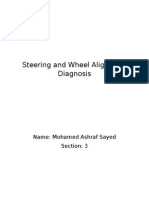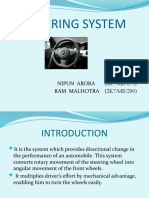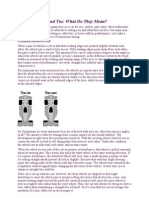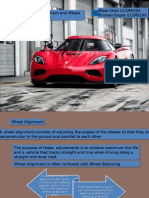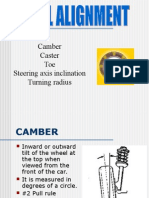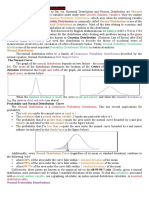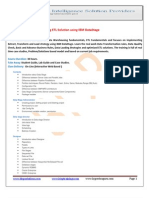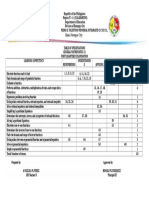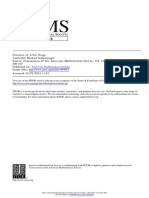Mannual Wheel Alignmen
Mannual Wheel Alignmen
Uploaded by
Gaurao WarungaseCopyright:
Available Formats
Mannual Wheel Alignmen
Mannual Wheel Alignmen
Uploaded by
Gaurao WarungaseOriginal Description:
Copyright
Available Formats
Share this document
Did you find this document useful?
Is this content inappropriate?
Copyright:
Available Formats
Mannual Wheel Alignmen
Mannual Wheel Alignmen
Uploaded by
Gaurao WarungaseCopyright:
Available Formats
What is an Alignment?
Adjusting wheel alignment. photo CC licensed by Adelelai1231
Wheel alignment is important to the health of your car or truck. If you hit a massive pothole, you might bump your suspension out of the carefully calculated locations that the components have been set. All of the elements that make your car go straight are called "alignment." Some shops try to make it seem like rocket science, but wheel alignment is a fairly straightforward affair. The inclusive term "wheel alignment" involves three main measurements -- caster, camber, and toe. These measurements have standards that a technician uses as targets of adjustment. In other words, get as close as you can to the right measurement. The good news is that most modern cars only have adjustments for toe. Caster and camber went the way of the dodo thanks to the McPherson strut.
Wheel Alignment Defined
By Matthew Wright, About.com Guide
See More About: 2 of 6 Prev Next suspension tires maintenance
Caster
Setting wheel alignment caster. About.com
Caster is the tilting of the uppermost point of the steering axis either forward or backward (when viewed from the side of the vehicle). A backward tilt is positive (+) and a forward tilt is negative (-). Caster influences directional control of the steering but does not affect the tire wear and is not adjustable on this vehicle. Caster is affected by the vehicle height, therefore it is important to keep the body at its designed height. Overloading the vehicle or a weak or sagging rear spring will affect caster. When the rear of the vehicle is lower than its designated trim height, the front suspension moves to a more positive caster. If the rear of the vehicle is higher than its designated trim height, the front suspension moves to a less positive caster. With too little positive caster, steering may be touchy at high speed and wheel returnability may be diminished when coming out of a turn. If one wheel has more positive caster than the other, that wheel will pull toward the center of the vehicle. This condition will cause the vehicle to pull or lead to the side with the least amount of positive caster.
Wheel Alignment Defined
By Matthew Wright, About.com Guide
See More About: 3 of 6 Prev Next suspension tires maintenance
Camber
Setting wheel alignment camber. About.com
Camber is the tilting of the wheels from the vertical when viewed from the front of the vehicle. When the wheels tilt outward at the top, the camber is positive (+). When the wheel tilts inward at the top, the camber is negative (-). The amount of tilt is measured in degrees from the vertical. Camber settings influence the directional control and the tire wear. Too much positive camber will result in premature wear on the outside of the tire and cause excessive wear on the suspension parts. Too much negative camber will result in premature wear on the inside of the tire and cause excessive wear on the suspension parts.
Unequal side-to-side camber of 1 or more will cause the vehicle to pull or lead to the side with the most positive camber.
Toe (Toe In or Toe Out)
Toe is a measurement of how much the front and/or rear wheels are turned in or out from a straight-ahead position. When the wheels are turned in, toe is positive (+). When the wheels are turned out, toe is negative (). The actual amount of toe is normally only a fraction of a degree. The purpose of toe is to ensure that the wheels roll parallel. Toe also serves to offset the small deflections of the wheel support system that occur when the vehicle is rolling forward. In other words, with the vehicle standing still and the wheels set with toe-in, the wheels tend to roll parallel on the road when the vehicle is moving. Improper toe adjustment will cause premature tire wear and cause steering instability.
Thrust Angle, Included Angle and Steering Axis Inclination
Thrust Angle: The angle between the thrust line and centerline. If the thrust line is to the right of the centerline, the angle is said to be positive. If the thrust line is to the left of center, the angle is negative. It is caused by rear wheel or axle misalignment and causes the steering to pull or lead to one side or the other. It is the primary cause of an off-center or crooked steering wheel. Correcting rear axle or toe alignment is necessary to eliminate the thrust angle. If that is not possible, using the thrust angle as a reference line for aligning front toe can restore center steering. Included Angle: The sum of the camber and SAI angles in a front suspension. This angle is measured indirectly and is used primarily to diagnose bent suspension parts such as spindles and struts. Steering Axis Inclination (SAI): The angle formed by a line that runs through the upper and lower steering pivots with respect to vertical. On a SLA suspension, the line runs through the upper and lower ball joints. On a MacPherson strut suspension, the line runs through the lower ball joint and upper strut mount or bearing plate. Viewed from the front, SAI is also the inward tilt of the steering axis. Like caster, it provides directional stability. But it also reduces steering effort by reducing the scrub radius. SAI is a built-in nonadjustable angle and is used with camber and the included angle to diagnose bent spindles, struts and mislocated crossmembers.
Kingpins, Set Back, and Ride Height
Kingpin Offset/Scrub Radius: Kingpin offset is the distance from the center of the wheel contact face to the intersection point of the kingpin extension. The line through the center point of the spring strut support bearing and the control arm ball joint corresponds to the "kingpin". The scrub radius is influenced by camber, kingpin angle and wheel offset of the wheel rim. This is set at the factory and is not adjustable.
Set Back: Set back is the amount by which one front wheel is further back from the front of the vehicle than the other. It is also the angle formed by a line perpendicular to the axle centerline with respect to the vehicle's centerline. If the left wheel is further back than the right, setback is negative. If the right wheel is further back than the left, setback is positive. Setback should usually be zero to less than half a degree, but some vehicles have asymmetrical suspensions by design. Setback is measured with both wheels straight ahead, and is used as a diagnostic angle along with caster to identify chassis misalignment or collision damage. The presence of setback can also cause differences in toe-out on turn angle readings side-to-side. Ride Height: Ride height is the distance between a specified point on the chassis, suspension or body and the ground. Measuring ride height is an indirect method of determining spring height, which is important because it affects camber, caster and toe. Low ride height indicates weak or sagging springs. Ride height should be within specifications before the wheels are aligned.
You might also like
- The Perfect Corner 2: A Driver's Step-by-Step Guide to Optimizing Complex Sections Through the Physics of RacingFrom EverandThe Perfect Corner 2: A Driver's Step-by-Step Guide to Optimizing Complex Sections Through the Physics of RacingNo ratings yet
- Chapter 7-STEERING System-1 PDFDocument22 pagesChapter 7-STEERING System-1 PDFShivam AgarwalNo ratings yet
- Wheel - Alignment HandoutsDocument21 pagesWheel - Alignment HandoutsJih Yan Lai50% (2)
- Steering and Wheel Alignment DiagnosisDocument23 pagesSteering and Wheel Alignment DiagnosismohamedashrafsayedNo ratings yet
- AlignmentDocument15 pagesAlignmentLahm KurosakiNo ratings yet
- Wheel Alignment ExplainedDocument19 pagesWheel Alignment ExplainedManny AnacletoNo ratings yet
- Basic Wheel Alignment Techniques: Mastering The BasicsDocument5 pagesBasic Wheel Alignment Techniques: Mastering The BasicsAmiNo ratings yet
- Wheel Alignment ExplainedDocument12 pagesWheel Alignment Explainedftsworld100% (1)
- LG # 4 Wheel AlignmentDocument57 pagesLG # 4 Wheel Alignmenttedozego9No ratings yet
- Wheel Alignment ExplainedDocument8 pagesWheel Alignment ExplainedThirupathi Rajan100% (1)
- Wheel Alignment PrinciplesDocument47 pagesWheel Alignment PrinciplesAlex MTB100% (1)
- CasterDocument25 pagesCasterግሩም ግብርከNo ratings yet
- Wheel Alignment: ExplainedDocument3 pagesWheel Alignment: ExplainedShi NeeNo ratings yet
- TOPIC32 - Wheel Alignment Principles AgorRheaDocument23 pagesTOPIC32 - Wheel Alignment Principles AgorRheajellyroserellesivaNo ratings yet
- Steering Geometry AnglesDocument12 pagesSteering Geometry AnglesMohit RanaNo ratings yet
- Steering System: Made By: Nipun Arora (2K7/Me/273) Ram Malhotra (2K7/Me/290)Document50 pagesSteering System: Made By: Nipun Arora (2K7/Me/273) Ram Malhotra (2K7/Me/290)Nipun AroraNo ratings yet
- Wheel AlignmentDocument7 pagesWheel AlignmentJOIJODENo ratings yet
- Camber AnglesDocument8 pagesCamber AnglesAbhishek Sharma100% (2)
- Chapter 5 - SteeringDocument15 pagesChapter 5 - SteeringLalith Koushik Ganganapalli100% (1)
- AUTOMOBILE (4) 3 - Wheel AlignmentDocument15 pagesAUTOMOBILE (4) 3 - Wheel AlignmentArun V NairNo ratings yet
- Camber, Caster and Toe: What Do They Mean?Document5 pagesCamber, Caster and Toe: What Do They Mean?harley1192No ratings yet
- Camber Caster Toe 7 PagesDocument7 pagesCamber Caster Toe 7 PagesTeresa HollidayNo ratings yet
- Caster, Cambercaster, ToeDocument6 pagesCaster, Cambercaster, ToeRajat GiteNo ratings yet
- Automobile Engineering Experiment 10: Study of Camber, Caster, Toe-In or Toe-Out CamberDocument4 pagesAutomobile Engineering Experiment 10: Study of Camber, Caster, Toe-In or Toe-Out Cambersai ChaitanyaNo ratings yet
- Wheel AlignmentDocument45 pagesWheel AlignmentViswajith Vm100% (1)
- Caster CamberDocument8 pagesCaster CamberDipesh KhatiwadaNo ratings yet
- Alignment Angles ExplainedDocument4 pagesAlignment Angles ExplainedAnonymous QiMB2lBCJLNo ratings yet
- SteeringDocument114 pagesSteeringanshuman sharmaNo ratings yet
- AutoDocument4 pagesAutoArsalan SajidNo ratings yet
- Suspension Geometry PDFDocument21 pagesSuspension Geometry PDFmarthaaddotekuNo ratings yet
- 3-VDHS-Wheel -steer-KC3Document88 pages3-VDHS-Wheel -steer-KC3mukesh.sharma657No ratings yet
- Table of Contents Suspension SystemsDocument40 pagesTable of Contents Suspension SystemsMark Wainwright100% (1)
- Wheel Alignment and BalacingDocument10 pagesWheel Alignment and BalacingMeet ShahNo ratings yet
- Caster, Camber, ToeDocument6 pagesCaster, Camber, ToeASHUTOSH KUMARNo ratings yet
- Wheels - Four Wheel Alignment PDFDocument5 pagesWheels - Four Wheel Alignment PDFFlorin CostinNo ratings yet
- CHAPTER-3 Suspension SystemDocument159 pagesCHAPTER-3 Suspension SystemEssa YimerNo ratings yet
- Steering SystemDocument14 pagesSteering SystemRaghav NanyaNo ratings yet
- Chapter-Three: Suspension SystemDocument86 pagesChapter-Three: Suspension SystemMarew GetieNo ratings yet
- Suspension SystemDocument72 pagesSuspension SystemMubarek TeshomeNo ratings yet
- Camber, CasterDocument4 pagesCamber, Casterforza_lcnNo ratings yet
- Vehicle Steering SystemDocument13 pagesVehicle Steering SystemReinhardNo ratings yet
- FrontSuspension940Document33 pagesFrontSuspension940reklamszarokNo ratings yet
- How Does It Work?: Positive and Negative CamberDocument1 pageHow Does It Work?: Positive and Negative CamberAnubhav SinghNo ratings yet
- SuspensionDocument159 pagesSuspensionMubarek TeshomeNo ratings yet
- Steering SystemDocument32 pagesSteering Systemaashish koiralaNo ratings yet
- Anti Roll Bar or Stabilizer and AnglesDocument13 pagesAnti Roll Bar or Stabilizer and AnglesPavan KumarNo ratings yet
- Front Axle - Steering GeometryDocument50 pagesFront Axle - Steering GeometryNaveen Vachipalli0% (1)
- Front Wheel AlignmentDocument19 pagesFront Wheel AlignmentFajar Setiawan J SNo ratings yet
- Alignment Angle EffectsDocument5 pagesAlignment Angle EffectsVincentius NikimNo ratings yet
- Wheel AlignmentDocument18 pagesWheel AlignmentARASAN100% (2)
- Wheel Alignment BasicsDocument19 pagesWheel Alignment BasicsAnnamalai Palaniappan100% (1)
- Steering GeometryDocument11 pagesSteering Geometryganeshmandala9293No ratings yet
- Chapter-Six: Suspension SystemDocument160 pagesChapter-Six: Suspension SystemMikias BelaynehNo ratings yet
- Camber CasterDocument12 pagesCamber CasterHarsh BhaskarNo ratings yet
- Automotive Steering SystemDocument31 pagesAutomotive Steering SystemTanzim Rafat AyonNo ratings yet
- Steering Gears Steering MechanismsDocument36 pagesSteering Gears Steering MechanismsSapari VelNo ratings yet
- ECN TemplateDocument3 pagesECN TemplateGaurao WarungaseNo ratings yet
- X BAR R ChartDocument4 pagesX BAR R ChartGaurao WarungaseNo ratings yet
- Paper Presentation On Developing Supply Chain Management Stratergy For Indian Foundry SectorDocument14 pagesPaper Presentation On Developing Supply Chain Management Stratergy For Indian Foundry SectorGaurao WarungaseNo ratings yet
- Sequential Fuel InjectionDocument20 pagesSequential Fuel InjectionGaurao WarungaseNo ratings yet
- Gasoline Direct InjectionDocument25 pagesGasoline Direct InjectionGaurao WarungaseNo ratings yet
- Sequential Fuel InjectionDocument20 pagesSequential Fuel InjectionGaurao WarungaseNo ratings yet
- What Is DTS-iDocument8 pagesWhat Is DTS-iGaurao WarungaseNo ratings yet
- Fuel Cell As Alternative FuelDocument11 pagesFuel Cell As Alternative FuelGaurao WarungaseNo ratings yet
- EXPT. 1 Common Laboratory OperationsDocument8 pagesEXPT. 1 Common Laboratory Operationsjazzmin dulceNo ratings yet
- Figuratively SpeakingDocument144 pagesFiguratively Speakingdknow75No ratings yet
- PrepositionsDocument60 pagesPrepositionsHector Rodriguez100% (2)
- Nucleophiles and NucleophilicityDocument13 pagesNucleophiles and NucleophilicityGrenlyKerehNo ratings yet
- Data Center Acceleration: Dave Salvator, Senior Manager, Product Management, NVIDIADocument9 pagesData Center Acceleration: Dave Salvator, Senior Manager, Product Management, NVIDIAKano SilvaNo ratings yet
- Fisher Chemical CatalogueDocument340 pagesFisher Chemical Cataloguepankaj645924No ratings yet
- Industrial Diesel Generator Set - 50 HZ: KOHLER SDMO Premium QualityDocument7 pagesIndustrial Diesel Generator Set - 50 HZ: KOHLER SDMO Premium QualityJoanCarlesLLopysNo ratings yet
- Probleme Controversate de Morfologie Si Sintaxa A Limbii EnglezeDocument45 pagesProbleme Controversate de Morfologie Si Sintaxa A Limbii EnglezeandreeagainaNo ratings yet
- JD770 Calibration of Transmission ControllerDocument3 pagesJD770 Calibration of Transmission Controllerenriquevazquez27No ratings yet
- M3.Normal Distribution - Final PDFDocument23 pagesM3.Normal Distribution - Final PDFÖzZíé Ming RenNo ratings yet
- Economics Assignment Group 5Document6 pagesEconomics Assignment Group 5Jaymeet PatilNo ratings yet
- Operator Manualome36380d1 Far15x3 15x8 BBDocument203 pagesOperator Manualome36380d1 Far15x3 15x8 BBJairo SantistebanNo ratings yet
- 2013 Electives 101 PrimerDocument47 pages2013 Electives 101 PrimerMarieNo ratings yet
- Compact 120 Tank Gun BrochureDocument4 pagesCompact 120 Tank Gun BrochureMeor Amri67% (3)
- Data StageDocument2 pagesData StageAmit SharmaNo ratings yet
- 250 To 5000 Watts PWM DCAC 220V Power InverterDocument9 pages250 To 5000 Watts PWM DCAC 220V Power InverterRommel RosillonNo ratings yet
- Merit Science Academy Faisalabad: Chemistry 2 YearDocument1 pageMerit Science Academy Faisalabad: Chemistry 2 YearShakaibNo ratings yet
- iGCSE 0478 Computer Science Unit I - Checklist - 2023 - NewDocument5 pagesiGCSE 0478 Computer Science Unit I - Checklist - 2023 - NewtechnabooksNo ratings yet
- Microsoft Word - CE - II - 2011Document32 pagesMicrosoft Word - CE - II - 2011Narpat JeengarNo ratings yet
- Table of SpecificationDocument1 pageTable of SpecificationAngelica Manalo PerezNo ratings yet
- American Mathematical SocietyDocument16 pagesAmerican Mathematical Societymarcel levillerNo ratings yet
- EEA-430 Introduction To Mechatronics: D R. Abdul Attayyab Khan Email AddressDocument18 pagesEEA-430 Introduction To Mechatronics: D R. Abdul Attayyab Khan Email AddressAamir MansoorNo ratings yet
- Creative Craft IdeasDocument85 pagesCreative Craft Ideaseddiept2000100% (3)
- AuxinsDocument16 pagesAuxinsICPH 2021No ratings yet
- Body Dimension DiagramDocument10 pagesBody Dimension DiagramDwi Rizky Febriyanto IpepNo ratings yet
- Module 2-Actual Cycle AnalysisDocument4 pagesModule 2-Actual Cycle AnalysissajithukNo ratings yet
- HTB 313K (2V) Series Cyclic Performance V1.3, 21st Oct 2015Document5 pagesHTB 313K (2V) Series Cyclic Performance V1.3, 21st Oct 2015M. ShaatNo ratings yet
- REAKTOR Blocks Framework Manual English PDFDocument61 pagesREAKTOR Blocks Framework Manual English PDFEduardo GuzmánNo ratings yet
- IT Skill Lab-2: Raj School of Management & SciencesDocument38 pagesIT Skill Lab-2: Raj School of Management & Sciencesindia cybercafeNo ratings yet
- 2 EuclidDocument25 pages2 EuclidLorie Mae MicarisNo ratings yet



